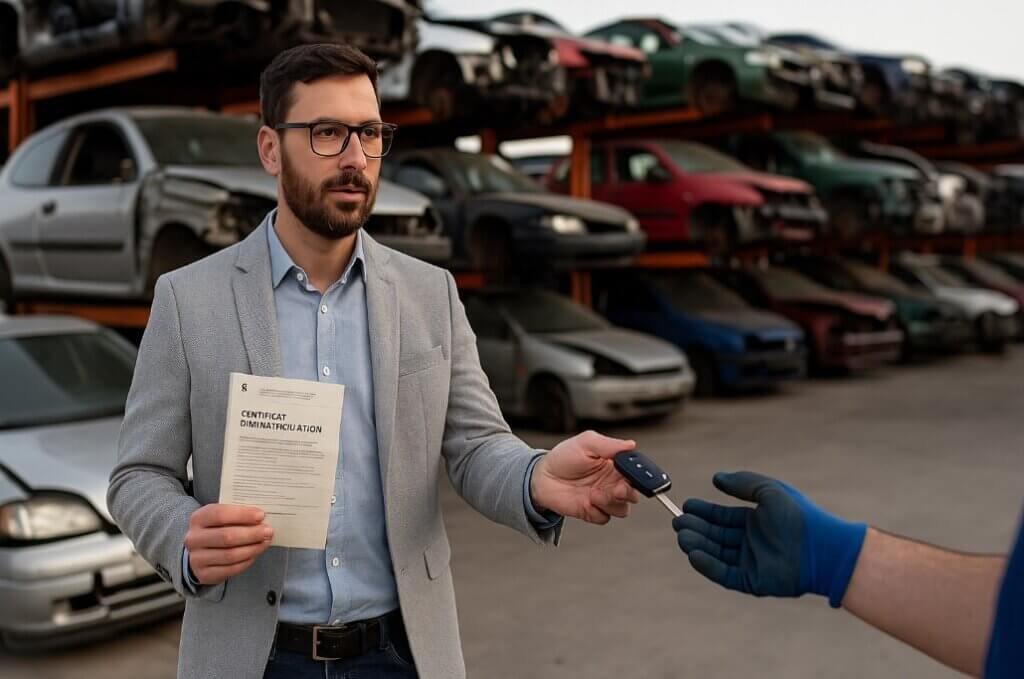What is a car wreck?
Used Parts Search
A car scrapyard, also known as a VHU (End-of-Life Vehicle) center, is a company specializing in the recovery, dismantling, resale, and recycling of end-of-life vehicles. When a vehicle is no longer roadworthy or its owner wishes to dispose of it, it can be taken to a scrapyard. There, the still-functional parts are carefully dismantled for resale as second-hand vehicles, while non-reusable components are recycled or destroyed in accordance with current environmental standards.
Why is this interesting for motorists?
For drivers, scrapyards represent a real opportunity:
✅ Find spare parts at a lower cost (up to 90% cheaper than new)
✅ Participate in an ecological approach by reusing parts instead of producing new ones, thus reducing the carbon footprint; ✅
Access rare parts, especially for older or discontinued models;✅
Avoid waste by giving a second life to components that are still in good condition. Find spare parts at a lower cost (up to 90% cheaper than new ones)
One of the main advantages of auto wreckers is the substantial savings they offer. Buying new spare parts can quickly become a financial drain, especially for technical components like alternators, gearboxes, engines, or bumpers. However, by turning to an auto wrecker, motorists can access these same components for a fraction of the price.
On average, a used part from a wrecker can cost 30% to 90% less. than its new equivalent. This saving is particularly significant for routine repairs (mirrors, headlights, handles, batteries) but also for heavier parts (clutch, exhaust, radiator). Why such a difference?
Immediate depreciation : A part salvaged from a scrap vehicle, even in perfect condition, is automatically considered used and sees its price drop, even if it is almost new. No middlemen
: Scrap yards often sell directly to individuals or garages, without the margins associated with traditional distributors.
- Varied offering : Scrap yards have inventory from numerous vehicles (wrecks, trade-ins, accidents), allowing them to offer a wide range adaptable to almost any budget.
- Finally, it is important to note that parts sold by authorized scrap yards are checked
- before being put on the shelves: they are tested, inspected, and often guaranteed for several months, which offers an excellent compromise between low price and safety. How a Car Junkyard Works What You Can Find at a Car Junkyard
Car junkyards play a key role in the recovery of end-of-life vehicles. Thanks to a rigorous sorting process, they fully participate in the circular economy, giving a second life to thousands of parts that would otherwise have ended up in landfill. But what exactly can you find there? Parts Often Available In most car junkyards, you’ll find a wide range of components, carefully disassembled, cleaned, and identified. Among the most common:

Mirrors, bumpers, headlights, taillights, perfect for repairing after a fender bender.
Tire parts in good condition, offering an economical and sustainable solution. Batteries, starters, alternators , to restore energy to your vehicle.Electronic components, such as car radios, computers, and sensors, are increasingly popular.Thanks to improved parts traceability, customers can now buy with confidence, with clear information on the origin, condition, and compatibility of components.
Rare or specific parts depending on the model
Auto wreckers are often the only places to find:
- Parts for older or less common models, for which manufacturers have ceased production.Parts specific to certain finishes or limited editions.
- Original accessories, such as specific rims, vintage seats, or integrated electronic equipment.This ability to locate specific parts directly contributes to limiting the environmental impact of the automotive industry by avoiding the need to manufacture new components, which can be costly in terms of resources and energy. Parts for Classic Cars / Collector Vehicles
- For classic car enthusiasts, junkyards are true hidden treasures. They provide a great opportunity to find original parts for faithfully restoring classic cars, whether it’s bodywork, mechanicals, or even interior trim. This heritage aspect fully contributes to the preservation of automotive heritage, while respecting the principles of the circular economy.📊
- Key Figures and European Standards for Automotive Recycling✅
- 1.5 million end-of-life vehicles (ELVs) are processed each year in France.✅
95%: This is the European target for the recovery of ELVs, set by European Directive 2000/53/EC. This means that at least 95% of a vehicle’s total weight must be recycled or recovered (reuse, energy recovery, etc.). ✅85%
: Minimum material recycling required, with the remainder being recovered in other forms (e.g., energy).
✅
- More than 2,000 approved ELV centers
- in France, complying with strict pollution control and traceability standards.
- ✅
Up to 700 kg of recovered materials per vehicle, including metals (steel, aluminum), plastics, glass, and textiles. 🌍
Applicable standards and regulations
European Directive 2000/53/EC : Regulates the processing of ELVs, requires pollution control, sets recycling targets, and restricts the use of hazardous substances in new vehicles. French Environmental Code
: Requires auto wreckers to obtain prefectural approval, guarantees compliance with environmental standards, and requires the maintenance of a register to ensure the traceability of vehicles and parts. ISO 14001 (for some companies): a voluntary environmental management standard aimed at limiting the ecological impact of activities. Let’s take GPA scrapyards as an example.
GPA: expertise serving sustainable mobility. For over 60 years, GPA has established itself as a major player in the circular automotive economy in France. Specializing in the recycling of end-of-life vehicles (ELVs), GPA transforms each end-of-life vehicle into a source of sustainable opportunities. You can purchase your parts online from GPA26 scrapyards. The company offers both individuals and professionals (garages, dealerships, repairers) a vast catalog of recycled spare parts, combining quality, traceability, and controlled environmental impact. Why choose GPA?
✔ Recognized technical expertise Every part produced in our workshops is carefully disassembled, tested, and inspected according to strict standards, guaranteeing optimal reliability. Whether you’re looking for an engine, a gearbox, an alternator, or a rearview mirror, you benefit from a fully traceable product, accompanied by all the necessary guarantees to drive with complete confidence.
✔ An eco-responsible and transparent approach At GPA, we place environmental impact at the heart of our actions. Thanks to our innovative processes, we reinject thousands of parts into the recycling cycle each year, thus reducing the production of new parts and limiting waste. This saves resources and directly contributes to reducing the automotive sector’s carbon footprint.
✔ A vision focused on innovation With advanced digital tools, GPA facilitates access to its reclaimed parts via a simple search engine, seamless logistics, and exemplary parts traceability. We believe that innovation is the key to reinventing automotive recycling and supporting both individuals and professionals toward more sustainable solutions.
GPA, much more than a junkyard: a trusted partner Whether you’re an individual looking to repair your vehicle at a lower cost while respecting the environment, or a professional looking for reliable and responsible solutions, GPA is by your side. We believe in more responsible mobility, where each recycled part extends the life of vehicles while preserving natural resources. Join a committed community that is choosing more sustainable consumption.
📚 FAQ about Junkyards Is it safe to buy used parts?
- Yes! Parts sold at authorized scrapyards are rigorously inspected, tested, and often guaranteed. This allows you to get near-new quality at a much more competitive price, with guaranteed traceability. Can I return a part if it doesn’t fit?
- Absolutely. Most scrapyards offer a cooling-off period or exchange under certain conditions. Always check the terms and conditions before purchasing to avoid unpleasant surprises. How much does a scrapyard part cost on average?
- In general, used spare parts cost between 30% and 90% less than new parts. The exact price depends on the rarity, condition, and type of part. What types of vehicles are available?
You can find everything: city cars, utility vehicles, 4x4s, recent cars, and even classic vehicles. Scrapyards offer a wide range of vehicles to meet all needs.
.faq-section { max-width: 800px; margin: 0 auto; } .faq-section h2 { text-align: center; margin-bottom: 30px; } .faq-item { background: #fff; margin-bottom: 10px; border-radius: 10px; box-shadow: 0 2px 8px rgba(0,0,0,0.1); overflow: hidden; transition: all 0.3s ease; } .faq-question { padding: 15px 20px; cursor: pointer; font-size: 18px; font-weight: bold; position: relative; } .faq-question::after { content: ‘+’; position: absolute; right: 20px; font-size: 24px; transition: transform 0.3s ease; } .faq-item.active .faq-question::after { transform: rotate(45deg); } .faq-answer { max-height: 0; overflow: hidden; padding: 0 20px; background: #f0f0f0; transition: max-height 0.5s ease, padding 0.3s ease; } .faq-item.active .faq-answer { max-height: 200px; padding: 15px 20px; }

Which models are the most stolen in France?
In 2024, France saw its number of vehicle thefts once again approach worrying heights. Cars, the daily companions of millions of drivers, are no longer easy prey, but still attract the most cunning and organized greed. So, which models, despite…

How to sell your car to a junkyard?
Do you have an old car that no longer runs or has been in an accident? Rather than letting it gather dust, why not sell it to a scrapyard? This quick and easy solution not only allows you to properly…

Can an epileptic get car insurance?
The issue of access to car insurance for people with epilepsy deserves serious consideration. Epilepsy is a complex neurological condition affecting millions of people worldwide, which poses specific challenges for driving and insurance.What is the legal framework surrounding this situation?…




